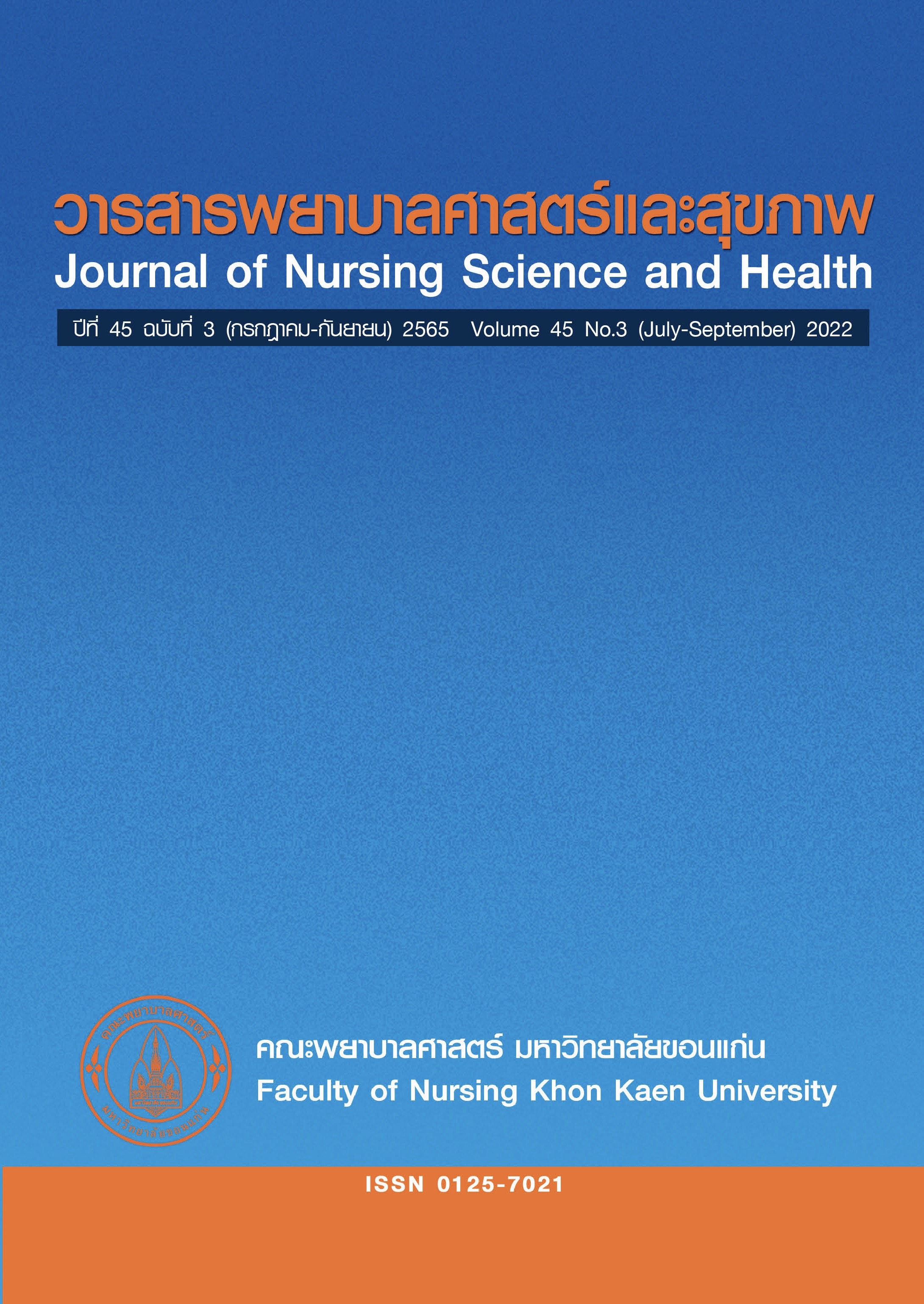ช่องว่างระหว่างวัย ช่องว่างวิจัยทางการพยาบาล
คำสำคัญ:
การวิจัยทางการพยาบาล, ความแตกต่างของช่วงวัยบทคัดย่อ
ความแตกต่างระหว่างวัยทำให้เกิดช่องว่างของคนต่างช่วงวัย โดยเฉพาะด้านค่านิยม การสื่อสาร และการดำเนินที่ชีวิตต่างกัน ในทางการพยาบาลนั้นความแตกต่างหลากหลายระหว่างวัยดังกล่าวมีผลกระทบทั้งทางบวก และทางลบต่อสัมพันธภาพส่วนบุคคล การสื่อสาร และการทำงานร่วมกัน บทความนี้มีเป้าหมายเพื่อกระตุ้นให้พยาบาลตั้งคำถาม และดำเนินงานวิจัยให้ได้คำตอบที่ลดช่องว่างระหว่างวัย และนำไปสู่การปฏิบัติการพยาบาลที่สร้างเสริมสุขภาวะต่อทั้งพยาบาล ทีมสุขภาพ และผู้รับบริการสุขภาพ โดยนำเสนอข้อมูลสังเขปตอบคำถาม 5 ประการคือ (1) โลกทุกวันนี้มีคนช่วงวัยใดบ้าง (2) นิสัยการทำงานของคนต่างช่วงวัยเป็นอย่างไร (3) คนในช่วงวัยต่าง ๆ ในสังคมปัจจุบันมีพฤติกรรมสุขภาพอย่างไร (4) จะใช้ความแตกต่างของช่วงวัยให้เกิดประโยชน์ด้านการพยาบาลได้อย่างไร และ (5) การพยาบาลไทยยังขาดองค์ความรู้ด้านความแตกต่างของช่วงวัยอะไรบ้างที่ต้องการงานวิจัย
เอกสารอ้างอิง
Boysen PG, Daste L, Northern T. Multigenerational challenges and the future of graduate medical education. Ochsner J 2016;16(1):101-7. PMID: 27046415; PMCID: PMC4795490.
Lancaster L, Stillman D. When generations collide. New York: Harper Business; 2002.
Murphy WM. Reverse Mentoring at Work: Fostering Cross-Generational Learning and Developing Millennial Leaders. Human Resource Management 2012;51(4):549-73. doi:10.1002/hrm.21489
Wolfinger E, McCrindle M. Generations defined. In: The ABC of XYZ: Understanding the global generations. Sydney: University of New South Wales Press: 2009, p.1–22.
Stevanin S, Voutilainen A, Bressan V, Vehviläinen-Julkunen K, Rosolen V, Kvist T. Nurses' generational differences related to workplace and leadership in two European countries. West J Nurs Res 2020;42(1):14-23. doi: 10.1177/0193945919838604. Epub 2019 Apr 3. PMID: 30943872.
Chupan S. Generation Y professional nurses: A challenge for nursing administrators. NJPH 2018;28(1):1-12. (in Thai)
Papp-Zipernovszky O, Horváth MD, Schulz PJ, Csabai M. Generation gaps in digital health literacy and their impact on health information seeking behavior and health empowerment in Hungary. Front Public Health 2021;(13)9:635943. doi: 10.3389/fpubh.2021.635943. PMID: 34055714; PMCID: PMC8158579.
McClain AR, Arnold A, Palokas M, Christian R. Retention strategies and barriers for millennial nurses: A scoping review protocol. JBI Evid Synth 2021;19(4):867-73. doi: 10.11124/JBIES-20-00091.
Hezaveh MS, Rafii F, Seyedfatemi N. Novice nurses' experiences of unpreparedness at the beginning of the work. Global Journal of Health Science 2014;6(1):215–22. doi:10.5539/gjhs.v6n1p215.
Olson, VD. Generational diversity: Implications for healthcare leaders. JBER 2008;6(11):27-32. https://doi.org/10.19030/jber.v6i11.2486
Saenung S, Oumtanee A. How to communicated in generation Z nurses. JRTAN 2020;21(2):286-91. (in Thai)
Hendricks JM, Cope VC. Generational diversity: What nurse managers need to know. J Adv Nurs 2013; 69(3):717-25. doi: 10.1111/j.1365-2648.2012.06079.x. Epub 2012 Jul 9. PMID: 22775766.
Burkoski VJ, Yoon D, Hutchinson S, Collins BE. Experiences of nurses working in a fully digital hospital: A phenomenological study. Canadian Journal of Nursing Leadership 2019;32 suppl:72–85.
Kuo YL, Lee JT, Yeh MY. Intergenerational narrative learning to bridge the generation gap in humanistic care nursing education. Healthcare 2021;9:1291. Available from: https://doi.org/10.3390/healthcare9101291
Czaja SJ, Charness N, Fisk AD, Hertzog C, Nair SD, Rogers WA, et al. Factors predicting the use of technology: Findings from the center for research and education on aging and technology enhancement (CREATE). Psychology and Aging 2006;21(2):333–52.
Cekada TL. Training a multigenerational workforce. Professional Safety 2012;57(3):40-4.
Brenner SK, Kaushal R, Grinspan Z, Joyce C, Kim I, Allard R, et al. Effects of health information technology on patient outcomes: A systematic review. Journal of the American Medical Informatics Association 2016;23(5):1016–36.
18.Kutney-Lee A, Kelly D. The effect of hospital electronic health record adoption on nurse-asessed quality of care and patient safety. J Nurs Adm 2011;41(11):466–72.
19.Healthcare Information and Management System Society. Himss conference and exhibition happening in Chicago [Internet]. Chicago: Healthcare Information and Management System Society;2021. Available from: https://10times.com/hit-forum-lasvegas
20.American Hospital Association. There may be a generation gap in telehealth’s future. Washington: American Hospital Association;2021. Available from: https://www. aha.org/aha-center-health-innovation-market-scan/2021-06-29-there-may-be-generation-gap-telehealths-future
21.Snyderman R. Personalized health care: From theory to practice. Biotechnology Journal 2012;7(8):973–9.
22.Buchanan TP, Sainter P, Saunders G. Factors affecting faculty use of learning technologies: Implications for models of technology adoption. Journal of Computing in Higher Education 2013;25(1):1–11. doi:10.1007/s12528-013-9066-6.
23.Litchfield JM. Matteis M. Faculty experiences with technology, millennials versus baby boomers. Journal of Nursing Informatics 2016;20(1):6-11.
ดาวน์โหลด
เผยแพร่แล้ว
รูปแบบการอ้างอิง
ฉบับ
ประเภทบทความ
สัญญาอนุญาต
ลิขสิทธิ์ (c) 2022 วารสารพยาบาลศาสตร์และสุขภาพ

อนุญาตภายใต้เงื่อนไข Creative Commons Attribution-NonCommercial-NoDerivatives 4.0 International License.
วารสารพยาบาลศาสตร์และสุขภาพเป็นเจ้าของลิขสิทธิ์ในการเผยแพร่ผลงานที่ตีพิมพ์ห้ามผู้ใดนำบทความที่ได้รับการตีพิมพ์ในวารสารพยาบาลศาสตร์และสุขภาพไปเผยแพร่ในลักษณะต่าง ๆ ดังนี้ การนำบทความไปเผยแพร่ออนไลน์ การถ่ายเอกสารบทความเพื่อกิจกรรมที่ไม่ใช่การเรียนการสอน การส่งบทความไปตีพิมพ์เผยแพร่ที่อื่น ยกเว้นเสียแต่ได้รับอนุญาตจากวารสารพยาบาลศาสตร์และสุขภาพ



